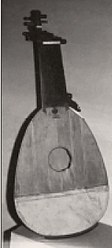Kobza
 |
|
| Classification | |
|---|---|
| Hornbostel–Sachs classification | 321.32-5 |
| Related instruments | |
| Lute, Mandora, Torban, Starosvitska bandura | |
The kobza (Ukrainian: кобза) is a Ukrainian folk music instrument of the lute family (Hornbostel-Sachs classification number 321.321-5+6), a relative of the Central European mandora. The term kobza however, has also been applied to a number of other Eastern European instruments distinct from the Ukrainian kobza.
The Ukrainian kobza was traditionally gut-strung, lute-like stringed musical instrument with a body hewn from a single block of wood. Instruments with a staved assembly also exist. The kobza has a medium length neck which may or may not have tied-on frets, which were usually made of gut. It was single-strung (sometimes also double-strung) and the strings were played with fingertips or occasionally with a plectrum threaded through a ring placed on the middle finger.
The term kobza is of Turkic origin and is related to the terms kobyz and komuz, thought to have been introduced into the Ukrainian language in the 13th century with the migration of a sizable group of Turkic people from Abkhazia settling in the Poltava region. It was usually played by a bard or minstrel known as a kobzar (occasionally in earlier times a kobeznik), who accompanies his recitation of epic poetry called duma in Ukrainian.
The Kobza acquired widespread popularity in the 16th century, with the advent of the Hetmanate (Cossack state). From the 17th century the term bandura was often used as a synonym for the kobza. The term bandura has a Latin pedigree and reflects the growing contacts the Ukrainian people had with Western Europe, particularly in the courts of Polish gentry. Ukrainian musicians that found employment at various German courts in the 18th century were called "pandoristen". One of these musicians, Timofiy Bilohradsky, was a lute student of Sylvius Leopold Weiss and later became a noted lute virtuoso, a court lutenist, active in Königsberg and St.Petersburg.
...
Wikipedia
